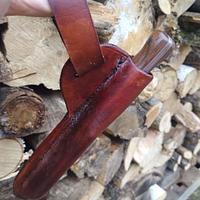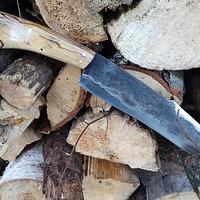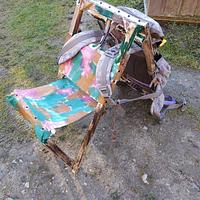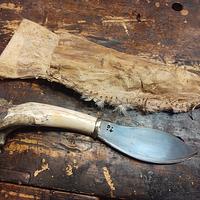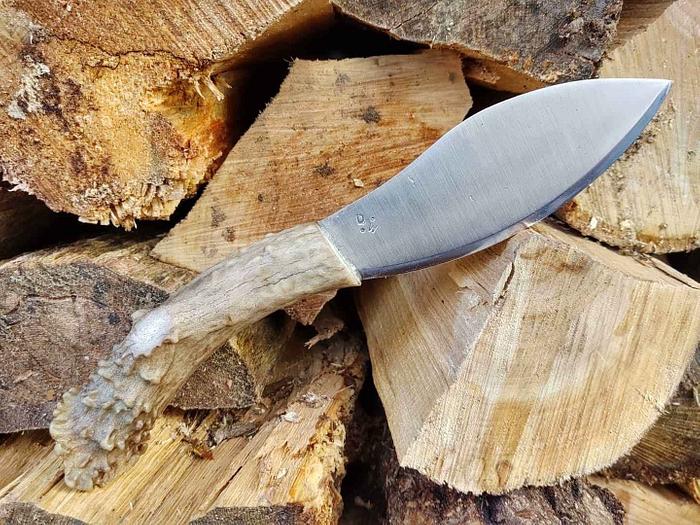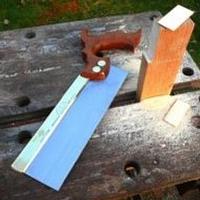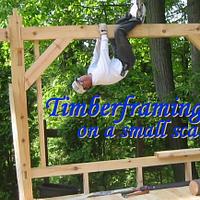Share your craft projects
Make new craft buddies
Ask craft questions
Blog your craft journey

Don
647 posts
and
29 followers
in almost 12 years
in almost 12 years
More from Don
This was my first Nessmuk (MUK) knife
Sometimes making a knife is more than just making a knife. Some knife styles have a history more interesting than others to the maker. Here I took a look at the Nessmuk knife or the Muk Knife.



The Muk knife is named after George Washington Sears (Nessmuk) (December 2, 1821 – May 1, 1890)), who made it popular when he wrote “Woodcraft”, an article published in Forest and Stream Publishing Company, New York, in 1920 and republished by Dover Publication Inc. in 1963. This “Nessmuk Trio” as it came to be known consists of a small double-bit axe, a moose pattern folding knife, and his now infamous fixed blade knife.The description in the text is as follows:“A word as to knife, or knives. These are of prime necessity, and should be of the best, both as to shape and temper. The “bowies” and “hunting knives” usually kept on sale, are thick, clumsy affairs, with a sort of ridge along the middle of the blade, murderous-looking, but of little use; rather fitted to adorn a dime novel or the belt of “Billy the Kid,” than the outfit of the hunter. The one shown in the cut is thin in the blade, and handy for skinning, cutting meat, or eating with. The strong double-bladed pocketknife is the best model I have yet found, and, in connection with the sheath knife, is all sufficient for camp use. It is not necessary to take table cutlery into the woods. A good fork may be improvised from a beech or birch stick; and the half of a fresh-water mussel shell, with a split stick by way of handle, makes an excellent spoon.”
The Nessmuk knife was carried in a small buckskin bullet pouch, and as stated
“which I wear almost as constantly as my hat. The pouch has a sheath strongly sewed on the back side of it, where the light hunting knife is always at hand.”
I wanted to make something to replicate the original. Blade is 3/32” 1095

Handle will be antler as the original appeared to beThe first thing I did was make a template, then I needed to straighten antler.

I boiled the antler for about 30 minutes.Clamped it in the vise and left it overnight.

The antler was added with the boiling method. I boiled the antler for about a half hour and tried to push it on. It only went part way so I boiled it again. I did that over and over until it was on all the way making sure to try to push straight on without moving it side to side in either direction. It took quite a few tried but came out great.A crack was created pushing the tang on. I filled it with super glue and worked borax into it while it was wet. It took two applications but after some light sanding the crack totally disappeared.
I made the blade out of 3/32” 1095 keeping with the original description of it being a thin knife. The antler was finished with multiple coats of tru-oil.
The blade is 5 ¼” and overall it is 10 ½” long.The knife feels really good in my hand. The natural curve of the antler creates a perfect drop and the curve in the knife allows your thumb to rest eliminating the need for jimping. The roughness of the antler was comfortable but kept your hand from sliding.
I started using conditioning belts on this knife. They are well worth looking into. They save a lot of hand sanding and provide a very nice satin finish.
-- There is nothing like the sound of a well tuned hand plane. - https://timetestedtools.net
7 Comments
love the look of that knife with the antler. i did not know about boiling antler to soften it it like that. good to know.
working with my hands is a joy,it gives me a sense of fulfillment,somthing so many seek and so few find.-SAM MALOOF.
just love the handle GR8 JOB 😍😎👍
*TONY ** Denver * ALWAYS REMEMBER TO HAVE FUN
Great knife Don! I assume the antler goes hard again once it dries out. Any concerns about rust putting the tang in wet antler?
Andy -- Old Chinese proverb say: If you think something can't be done, don't interrupt man who is doing it.
Excellent job on a really cool knife Don. I am keeping my eye out for a good sized piece of antler.
I assume the antler goes hard again once it dries out. Any concerns about rust putting the tang in wet antler?
The antler does return it's hardness. Rust is not a concern. The steel is hot enough that it evaporates quickly and once sealed so no air can reach it, rust needs oxygen to form.
-- There is nothing like the sound of a well tuned hand plane. - https://timetestedtools.net
Thanks for the post Don.
Not a knife person as can be seen from my 10 fingers and 10 toes, however, like pottzy, I've used antler quite a few times for pen blanks and it's nice to be aware of antler boiling.
Not a knife person as can be seen from my 10 fingers and 10 toes, however, like pottzy, I've used antler quite a few times for pen blanks and it's nice to be aware of antler boiling.
If your first cut is too short... Take the second cut from the longer end... LBD
Very nice work and interesting details.
I question the idea of the tang not rusting, only because I have rehandled a bunch of tang chisels over the years and often find the tang rusted when I remove the original handle. Sometimes just a wee bit, sometimes to the point of almost complete deterioration.
I try to wipe the tang with a thin layer of Tung oil before putting the new handle on. The next person to rehandle it in 50 or 100 years will have to contact my descendants and tell them whether it worked or not.
I question the idea of the tang not rusting, only because I have rehandled a bunch of tang chisels over the years and often find the tang rusted when I remove the original handle. Sometimes just a wee bit, sometimes to the point of almost complete deterioration.
I try to wipe the tang with a thin layer of Tung oil before putting the new handle on. The next person to rehandle it in 50 or 100 years will have to contact my descendants and tell them whether it worked or not.









